一般疑问句详解加练习答案
- 格式:docx
- 大小:17.37 KB
- 文档页数:5
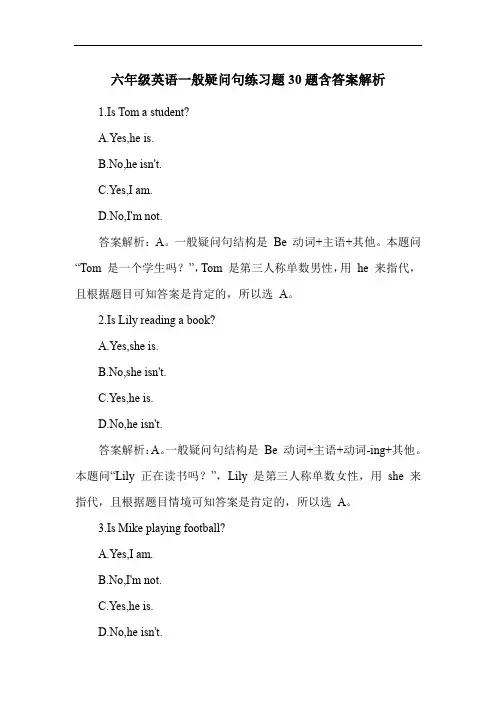
六年级英语一般疑问句练习题30题含答案解析1.Is Tom a student?A.Yes,he is.B.No,he isn't.C.Yes,I am.D.No,I'm not.答案解析:A。
一般疑问句结构是Be 动词+主语+其他。
本题问“Tom 是一个学生吗?”,Tom 是第三人称单数男性,用he 来指代,且根据题目可知答案是肯定的,所以选A。
2.Is Lily reading a book?A.Yes,she is.B.No,she isn't.C.Yes,he is.D.No,he isn't.答案解析:A。
一般疑问句结构是Be 动词+主语+动词-ing+其他。
本题问“Lily 正在读书吗?”,Lily 是第三人称单数女性,用she 来指代,且根据题目情境可知答案是肯定的,所以选A。
3.Is Mike playing football?A.Yes,I am.B.No,I'm not.C.Yes,he is.D.No,he isn't.答案解析:C。
一般疑问句结构是Be 动词+主语+动词-ing+其他。
本题问“Mike 正在踢足球吗?”,Mike 是第三人称单数男性,用he 来指代,且根据题目情境可知答案是肯定的,所以选C。
4.Is Amy singing a song?A.Yes,she is.B.No,she isn't.C.Yes,he is.D.No,he isn't.答案解析:A。
一般疑问句结构是Be 动词+主语+动词-ing+其他。
本题问“Amy 正在唱歌吗?”,Amy 是第三人称单数女性,用she 来指代,且根据题目情境可知答案是肯定的,所以选A。
5.Is Peter drawing a picture?A.Yes,he is.B.No,he isn't.C.Yes,she is.D.No,she isn't.答案解析:A。
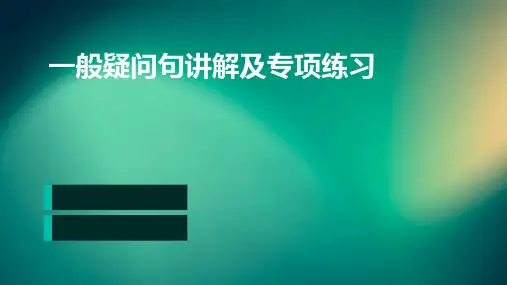
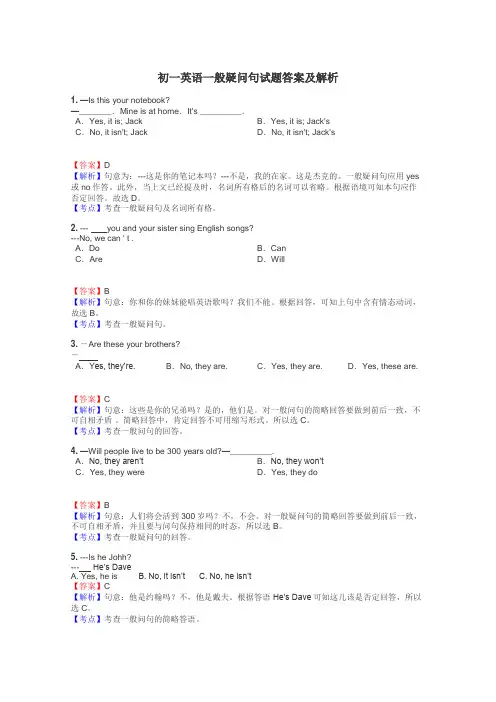
初一英语一般疑问句试题答案及解析1.—Is this your notebook?—_______.Mine is at home.It's _________.A.Yes, it is; Jack B.Yes, it is; Jack'sC.No, it isn't; Jack D.No, it isn't; Jack's【答案】D【解析】句意为:---这是你的笔记本吗?---不是,我的在家。
这是杰克的。
一般疑问句应用yes 或no作答。
此外,当上文已经提及时,名词所有格后的名词可以省略。
根据语境可知本句应作否定回答。
故选D。
【考点】考查一般疑问句及名词所有格。
2. --- you and your sister sing English songs?---No, we can ' t .A.Do B.CanC.Are D.Will【答案】B【解析】句意:你和你的妹妹能唱英语歌吗?我们不能。
根据回答,可知上句中含有情态动词,故选B。
【考点】考查一般疑问句。
3.-Are these your brothers?-A.Yes, they’re.B.No, they are.C.Yes, they are.D.Yes, these are.【答案】C【解析】句意:这些是你的兄弟吗?是的,他们是。
对一般问句的简略回答要做到前后一致,不可自相矛盾。
简略回答中,肯定回答不可用缩写形式。
所以选C。
【考点】考查一般问句的回答。
4.—Will people live to be 300 years old?—_________.A.No, they aren’t B.No, they won’tC.Yes, they were D.Yes, they do【答案】B【解析】句意:人们将会活到300岁吗?不,不会。
对一般疑问句的简略回答要做到前后一致,不可自相矛盾,并且要与问句保持相同的时态,所以选B。
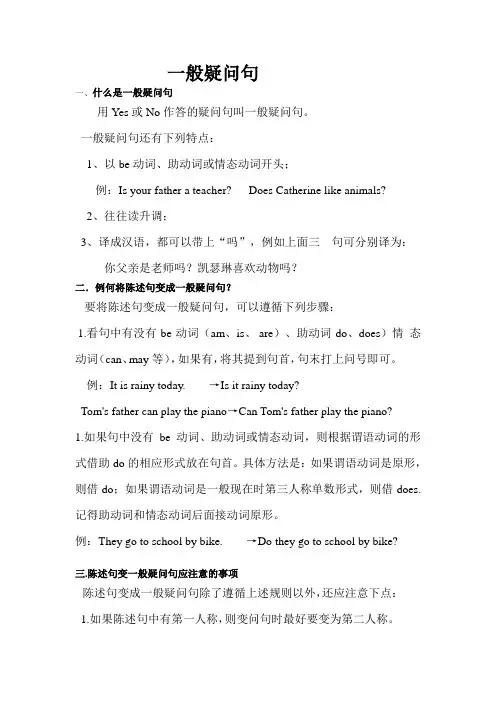
一般疑问句一、什么是一般疑问句用Yes或No作答的疑问句叫一般疑问句。
一般疑问句还有下列特点:1、以be动词、助动词或情态动词开头;例:Is your father a teacher? Does Catherine like animals?2、往往读升调;3、译成汉语,都可以带上“吗”,例如上面三句可分别译为:你父亲是老师吗?凯瑟琳喜欢动物吗?二.例何将陈述句变成一般疑问句?要将陈述句变成一般疑问句,可以遵循下列步骤:1.看句中有没有be动词(am、is、 are)、助动词do、does)情态动词(can、may等),如果有,将其提到句首,句末打上问号即可。
例:It is rainy today. →Is it rainy today?Tom's father can play the piano→Can Tom's father play the piano?1.如果句中没有be动词、助动词或情态动词,则根据谓语动词的形式借助do的相应形式放在句首。
具体方法是:如果谓语动词是原形,则借do;如果谓语动词是一般现在时第三人称单数形式,则借does.记得助动词和情态动词后面接动词原形。
例:They go to school by bike. →Do they go to school by bike?三.陈述句变一般疑问句应注意的事项陈述句变成一般疑问句除了遵循上述规则以外,还应注意下点:1.如果陈述句中有第一人称,则变问句时最好要变为第二人称。
I usually have lunch at school→Do you usually have lunch at school? My father is playing soccer. →Is your father playing soccer?2.如果陈述句中有some, 则变问句时往往要变成any 。
There is some water on the playground. →Is there any water on the playground?四.一般疑问句的回答一般疑问句往往采用简短回答,共由三部分(三个单词)组成,对这三部分(三个单词)的确定可以概括例下:1.第一个词:不是Yes就是No。
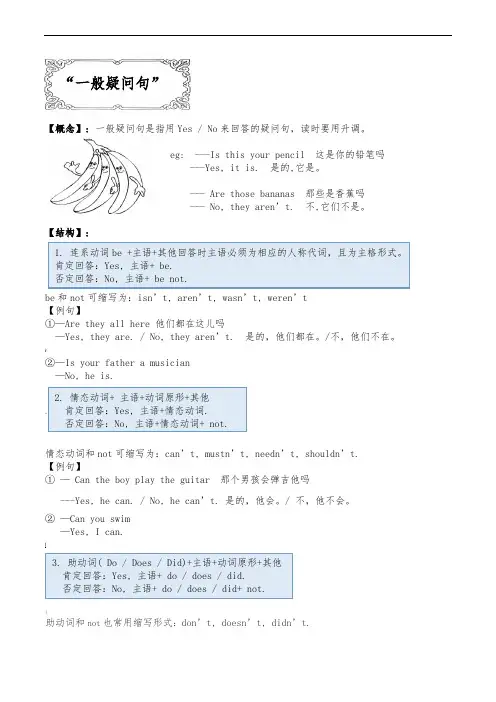
“一般疑问句”【概念】: 一般疑问句是指用Yes / No来回答的疑问句,读时要用升调。
eg: ---Is this your pencil 这是你的铅笔吗---Yes, it is. 是的,它是。
:--- Are those bananas 那些是香蕉吗--- No, they aren’t. 不,它们不是。
【结构】:1. 连系动词be +主语+其他回答时主语必须为相应的人称代词,且为主格形式。
肯定回答:Yes, 主语+ be.否定回答:No, 主语+ be not.be和not可缩写为:isn’t, aren’t, wasn’t, weren’t【例句】①—Are they all here 他们都在这儿吗—Yes, they are. / No, they aren’t. 是的,他们都在。
/不,他们不在。
)②—Is your father a musician—No, he is.2. 情态动词+ 主语+动词原形+其他肯定回答:Yes, 主语+情态动词.否定回答:No, 主语+情态动词+ not.情态动词和not可缩写为:can’t, mustn’t, needn’t, shouldn’t.【例句】①— Can the boy play the guitar 那个男孩会弹吉他吗---Yes, he can. / No, he can’t. 是的,他会。
/ 不,他不会。
②—Can you swim—Yes, I can.[3. 助动词( Do / Does / Did)+主语+动词原形+其他肯定回答:Yes, 主语+ do / does / did.否定回答:No, 主语+ do / does / did+ not.(助动词和not也常用缩写形式:don’t, doesn’t, didn’t.【例句】①—Do you want to go to the movie 你想去看电影吗—Yes, I do. / No, I don’t. 是的,我想去。
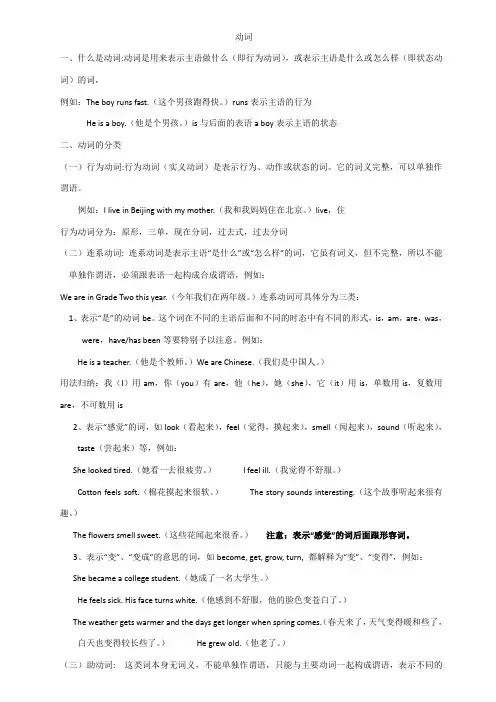
动词一、什么是动词:动词是用来表示主语做什么(即行为动词),或表示主语是什么或怎么样(即状态动词)的词,例如:The boy runs fast.(这个男孩跑得快。
)runs表示主语的行为He is a boy.(他是个男孩。
)is与后面的表语a boy表示主语的状态二、动词的分类(一)行为动词:行为动词(实义动词)是表示行为、动作或状态的词。
它的词义完整,可以单独作谓语。
例如:I live in Beijing with my mother.(我和我妈妈住在北京。
)live,住行为动词分为:原形,三单,现在分词,过去式,过去分词(二)连系动词: 连系动词是表示主语“是什么”或“怎么样”的词,它虽有词义,但不完整,所以不能单独作谓语,必须跟表语一起构成合成谓语,例如:We are in Grade Two this year.(今年我们在两年级。
)连系动词可具体分为三类:1、表示“是”的动词be。
这个词在不同的主语后面和不同的时态中有不同的形式,is,am,are,was,were,have/has been等要特别予以注意。
例如:He is a teacher.(他是个教师。
)We are Chinese.(我们是中国人。
)用法归纳:我(I)用am,你(you)有are,他(he),她(she),它(it)用is,单数用is,复数用are,不可数用is2、表示“感觉”的词,如look(看起来),feel(觉得,摸起来),smell(闻起来),sound(听起来),taste(尝起来)等,例如:She looked tired.(她看一去很疲劳。
)I feel ill.(我觉得不舒服。
)Cotton feels soft.(棉花摸起来很软。
)The story sounds interesting.(这个故事听起来很有趣。
)The flowers smell sweet.(这些花闻起来很香。
)注意:表示“感觉”的词后面跟形容词。
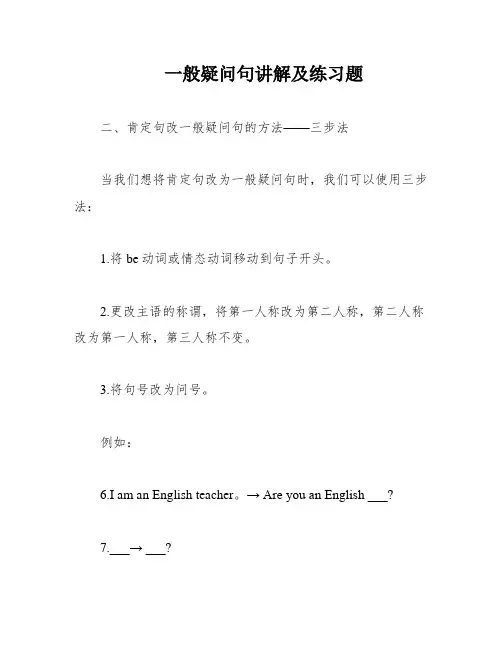
一般疑问句讲解及练习题二、肯定句改一般疑问句的方法——三步法当我们想将肯定句改为一般疑问句时,我们可以使用三步法:1.将be动词或情态动词移动到句子开头。
2.更改主语的称谓,将第一人称改为第二人称,第二人称改为第一人称,第三人称不变。
3.将句号改为问号。
例如:6.I am an English teacher。
→ Are you an English ___?7.___→ ___?练:请将以下句子改为一般疑问句:1.I am ___.2.Mike is a student.3.They are in the zoo.4.There are some flowers in the vase.5.This is my sister.6.___.7.There is an ostrich in the zoo.8.It is a beautiful park.9.It is a big map.10.You are a singer.1.Is it a lovely dog?2.Is she a lovely girl?3.Is he your father?4.Are they Lily's cousins?5.Are we classmates?6.Am I a doctor?7.Is there a bird in the tree?8.Are there many stars in the sky?9.Are they good friends?10.Are there many books on the shelf?___: add "do" or "does" at the beginning of the sentence。
change the verb to its base form。
and change the subject if necessary。

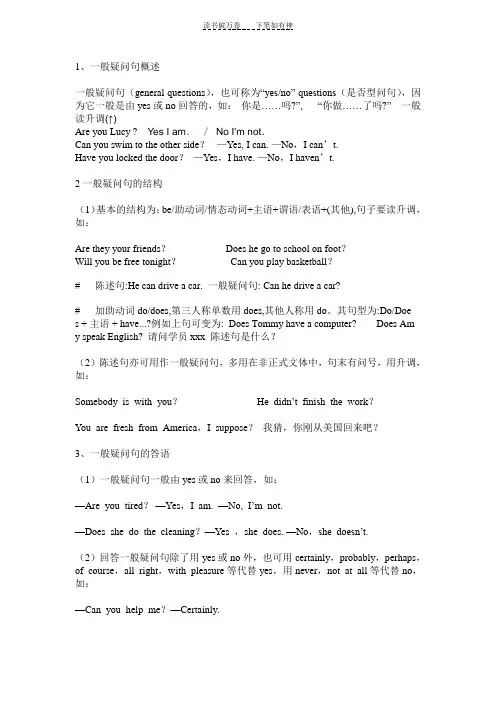
1、一般疑问句概述一般疑问句(general questions),也可称为“yes/no” questions(是否型问句),因为它一般是由yes或no回答的,如:你是……吗?”,“你做……了吗?”一般读升调(↑)Are you Lucy ? Yes I am./No I'm not.Can you swim to the other side?—Yes, I can. —No,I can’t.Have you locked the door?—Yes,I have. —No,I haven’t.2一般疑问句的结构(1)基本的结构为:be/助动词/情态动词+主语+谓语/表语+(其他),句子要读升调,如:Are they your friends?Does he go to school on foot?Will you be free tonight?Can you play basketball?# 陈述句:He can drive a car. 一般疑问句: Can he drive a car?# 加助动词do/does,第三人称单数用does,其他人称用do。
其句型为:Do/Does + 主语 + have...?例如上句可变为: Does Tommy have a computer? Does Amy speak English? 请问学员xxx 陈述句是什么?(2)陈述句亦可用作一般疑问句,多用在非正式文体中,句末有问号,用升调,如:Somebody is with you?He didn’t finish the wor k?You are fresh from America,I suppose?我猜,你刚从美国回来吧?3、一般疑问句的答语(1)一般疑问句一般由yes或no来回答,如:—Are you tired?—Yes,I am. —No, I’m not.—Does she do the cleaning?—Yes ,she does. —No,she doesn’t.(2)回答一般疑问句除了用yes或no外,也可用certainly,probably,perhaps,of course,all right,with pleasure等代替yes,用never,not at all等代替no,如:—Can you help me?—Certainly.—Could you please make less noise?—All right,sir.—Have you been there?—Never.Are they in town now?I think so. May I sit here?Certainly.Does he like soccer?Sorry I don't know.4、一般疑问句的否定式(1)一般疑问句的否定式,一般结构为系动词/助动词/情态动词+not+主语;也可为系动词/助动词/情态动词+主语+not,如:Do you not/Don’t you believe me? 你不相信我?Is it not / Isn’t it a lovely day? 天气难道不好吗?Are you not / Aren’t you coming?你不来吗?W ill you not /Won’t you sit down? 你不坐会儿吗?Is he not / Isn’t he a doctor? 他不是医生吗?Does Helen not /Doesn’t Helen like chocolate? 海伦不喜欢巧克力吗?Will he not /Won’t he go with you?他不和你一块儿去吗?(2)否定疑问句并不单纯表示提问,它常常带有感情色彩。
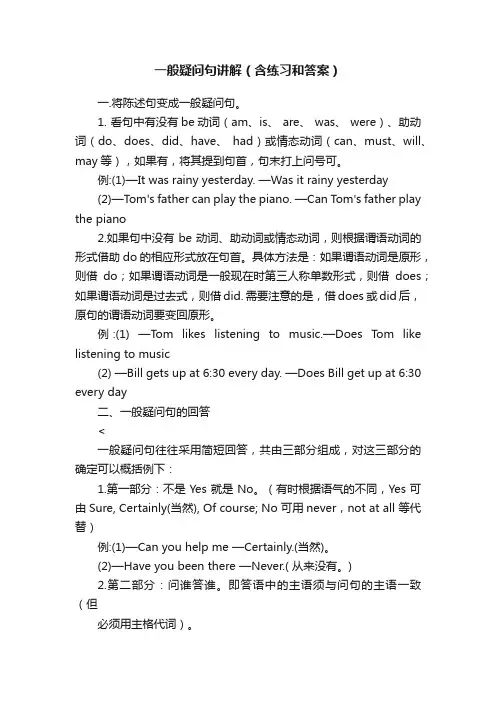
一般疑问句讲解(含练习和答案)一.将陈述句变成一般疑问句。
1. 看句中有没有be动词(am、is、 are、 was、 were)、助动词(do、does、did、have、had)或情态动词(can、must、will、may等),如果有,将其提到句首,句末打上问号可。
例:(1)—It was rainy yesterday. —Was it rainy yesterday(2)—T om's father can play the piano. —Can Tom's father play the piano2.如果句中没有be动词、助动词或情态动词,则根据谓语动词的形式借助do的相应形式放在句首。
具体方法是:如果谓语动词是原形,则借do;如果谓语动词是一般现在时第三人称单数形式,则借does;如果谓语动词是过去式,则借did. 需要注意的是,借does 或did后,原句的谓语动词要变回原形。
例:(1) —Tom likes listening to music.—Does Tom like listening to music(2) —Bill gets up at 6:30 every day. —Does Bill get up at 6:30 every day二、一般疑问句的回答<一般疑问句往往采用简短回答,共由三部分组成,对这三部分的确定可以概括例下:1.第一部分:不是Yes就是No。
(有时根据语气的不同,Yes可由Sure, Certainly(当然), Of course; No 可用never,not at all 等代替)例:(1)—Can you help me —Certainly.(当然)。
(2)—Have you been there —Never.( 从来没有。
)2.第二部分:问谁答谁。
即答语中的主语须与问句的主语一致(但必须用主格代词)。
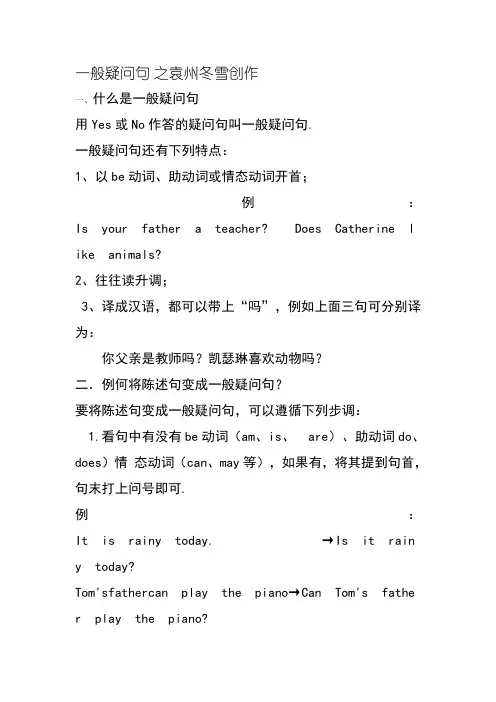
一般疑问句之袁州冬雪创作一、什么是一般疑问句用Yes或No作答的疑问句叫一般疑问句.一般疑问句还有下列特点:1、以be动词、助动词或情态动词开首;例:Is your father a teacher? Does Catherine l ike animals?2、往往读升调;3、译成汉语,都可以带上“吗”,例如上面三句可分别译为:你父亲是教师吗?凯瑟琳喜欢动物吗?二.例何将陈述句变成一般疑问句?要将陈述句变成一般疑问句,可以遵循下列步调:1.看句中有没有be动词(am、is、are)、助动词do、does)情态动词(can、may等),如果有,将其提到句首,句末打上问号即可.例:It is rainy today. →Is it rain y today?Tom'sfathercan play the piano→Can Tom's fathe r play the piano?1.如果句中没有be动词、助动词或情态动词,则根据谓语动词的形式借助do的相应形式放在句首.详细方法是:如果谓语动词是原形,则借do;如果谓语动词是一般现在时第三人称单数形式,则借does.记得助动词和情态动词后面接动词原形.例:They go to school by bike. →Do they go to school by bike?三.陈述句变一般疑问句应注意的事项陈述句变成一般疑问句除了遵循上述规则以外,还应注意下点:1.如果陈述句中有第一人称,则变问句时最好要变成第二人称.I usually have lunch at school→Do you usual ly have lunch at school?My father is playing soccer.→Is your father playing soccer?2.如果陈述句中有some, 则变问句时往往要变成any .There is some water on the playground.→Is there any water on the playgroun d?一般疑问句往往采取简短回答,共由三部分(三个单词)组成,对这三部分(三个单词)的确定可以概括例下:1.第一个词:不是Yes就是No.(有时根据语气的分歧,Yes 可由Sure, Certainly, Of course等代替.NO可由sorry 代替.)2.第二个词:问谁答谁.即答语中的主语须与问句的主语一致(但必须用主格代词).例:Does she clean her room every day? Yes, she does.Is Anna′s father a doctor? No,he isn′t.Are you a student ? Yes, I am .No, I’m not如果主语是this that,回答时用it 代替,如果问句中主语these, those,回答时用they 代替.3.第三个词:用什么问,用什么答.即沿用问句中的引导词.Can Jim play soccer? Yes, he can.Does Mr Bean speak English? Yes, he does.4.用No开首作否定回答时,开首要加上not.因为回答必须是三部分,所以否定回答必须缩写,而必定回答不克不及缩写.Is Lin Lin in Class 3? Yes, she is. / No, she isn′t.或(No, she′s not)操练一、把下面的句子变成一般疑问句并做回答.1.His father is an English teacher.2.These cats are crying.3.He is crying under the tree.4.His birthday is on the twentieth of Novemb er.5.Mrs. Li and Kitty are in a big shop.6.Kitty is wearing her new uniform.二、用适当的词语填空1> _ __ she know all the answers ? Y es , she ____ . No, she _____.2> _____ the twins often fight ? Y es ,____ do. No, _____ don’t.3> _does____ your dad like listening to musi c? Yes ,____ does . No, ____ doesn ’t.4>_____ uncle Tom wash his car everyday?Yes , ____ does . No, ____ doesn’t.5> _____ you have a new teacher? Y es , I ______. No, I ______.6>_____ she a teacher? Yes, she _ ____ . No, she _____.7> ______ you playing ball now? Yes, I __ ____. No, I ______.8> ______ the pig like to sleep? Yes , it ______. No, it _____.9> ______ five birds flying in the sky?Yes, they _____ .No, ____ aren’t.10> _____ your father smoking in the livingroom? Yes, ____ is .No, he _____. 课后小测将下列句子改成一般疑问句并回答.1.It is a lovely dog. __________________ ______________________2.She is a lovely girl. ________________ ________________________3.He is my father. ________________________ _________________4.They are Lily’s cousins. ________________ ___________________5.We are classmates. ________________________ ______________6I am a doctor._________________________________ _______7 There is a bird in the tree. __________ ______________________8. There are many stars in the sky.____________________________9.They are good friends. _______________ _____________________10.I love my parents. ______________________ _________________11.We have a pleasant home. _______________ ___________________12.We like to climb the mountain. ________ ______________________13.They go to church on Sunday. __________ ____________________14.They walk to school every morning. ____ ______________________15.I can swim. _____________________________ _讲堂操练答案一、1.Is his father an English teacher?Yes,he is . No, he isn’t.2.Are those cats crying?Yes,they are. No, theyaren’t.3.Is he crying under the tree? Yes,he is .No, he isn’t.3.Is his birthday on the twentieth of Novembe r? Yes,it is . No, it isn’t.4.Are Mrs. Li and Kitty in a big shop? Ye s,they are. No, they aren’t.5.Is she wearing her new uniform? Yes,she is. No, she isn’t.二.1 Does does does2.Do they they3.3.Does he he4.4. Does he he5.5.Do do do6.6.Is is is7.7. Are am am8.8. Does does does9.9.Are are they10.10. Is he isn’t课后小侧答案1.Is it a lovely dog? Yes,it is . No, itisn’t.2.Is she a lovely girl ? Yes,she is . No , she isn’t.3.Is he your father? Yes,he is . No, he isn’t.4.Are they Lily’s cousins? Yes,they are. N o, they aren’t.5.Are you classmates? Yes,we are. No, we aren’t.6. Are you a doctor? Yes , I am . No, I ’m not.7.Is there a bird in the tree? Yes ,thereis . No, there isn’t.8. Are there many stars in the sky ? Yes,there are . No, there aren’t.9. Are they good friends? Yes,they are. No,they aren’t.10. Do you love your parents? Yes,I do. No,I don’t.11. Do you have a pleasant home? Yes,I do.No,I don’t.12. Do you like to climb the mountain? Yes,I do. No,I don’t.13. Do they go to church on Sunday? Yes ,they do. No,they don’t14.Do they walk to school every morning?Yes,they do. No,they don’t.15.Can you swim? Yes,I can. No, I can’t。
1、一般疑问句概述一般疑问句(general questions),也可称为“yes/no” questions(是否型问句),因为它一般是由yes或no回答的,如:你是……吗”,“你做……了吗”一般读升调(↑)Are you Lucy Yes I am./ No I'm not.Can you swim to the other side —Yes, I can. —No,I can’t. Have you locked the door —Yes,I have. —No,I haven’t.2一般疑问句的结构(1)基本的结构为:be/助动词/情态动词+主语+谓语/表语+(其他),句子要读升调,如:Are they your friends Does he go to school on footWill you be free tonight Can you play basketball# 陈述句:He can drive a car. 一般疑问句: Can he drive a ca r# 加助动词do/does,第三人称单数用does,其他人称用do。
其句型为:Do/Doe s + 主语+ have...例如上句可变为: Does Tommy have a computer Does Amy speak English 请问学员xxx 陈述句是什么?(2)陈述句亦可用作一般疑问句,多用在非正式文体中,句末有问号,用升调,如:Somebody is with you He didn’t finish the workYou are fresh from America,I suppose 我猜,你刚从美国回来吧3、一般疑问句的答语(1)一般疑问句一般由yes或no来回答,如:—Are you tired —Yes,I am. —No, I’m not.—Does she do the cleaning—Yes ,she does. —No,she doesn’t.(2)回答一般疑问句除了用yes或no外,也可用certainly,probably,perh aps,of course,all right,with pleasure等代替yes,用never,not at a ll等代替no,如:—Can you help me—Certainly.—Could you please make less noise —All right,sir.—Have you been there —Never.Are they in town now I think so. May I sit hereCertainly.Does he like soccer Sorry I don't know.4、一般疑问句的否定式(1)一般疑问句的否定式,一般结构为系动词/助动词/情态动词+not+主语;也可为系动词/助动词/情态动词+主语+not,如:Do you not/Don’t you believe me 你不相信我?Is it not / Isn’t it a lovely day 天气难道不好吗Are you not / Aren’t you coming你不来吗Will you not /Won’t you sit d own 你不坐会儿吗Is he not / Isn’t he a doctor 他不是医生吗?Does Helen not /Doesn’t Helen like chocolate 海伦不喜欢巧克力吗?Will he not /Won’t he go with you他不和你一块儿去吗?(2)否定疑问句并不单纯表示提问,它常常带有感情色彩。
一般疑问句1、什么是一般疑问句用Yes或No作答的疑问句叫一般疑问句。
一般疑问句还有下列特点:1、以be动词、助动词或情态动词开头;例:Is your father a teacher? Does Catherine like animals?2、往往读升调;3、译成汉语,都可以带上“吗”,例如上面三句可分别译为:你父亲是老师吗?凯瑟琳喜欢动物吗?二.例何将陈述句变成一般疑问句?要将陈述句变成一般疑问句,可以遵循下列步骤:1.看句中有没有be动词(am、is、 are)、助动词do、does)情态动词(can、may等),如果有,将其提到句首,句末打上问号即可。
例:It is rainy today. →Is it rainy today?Tom's father can play the piano→Can Tom's father play the piano? 1.如果句中没有be动词、助动词或情态动词,则根据谓语动词的形式借助do的相应形式放在句首。
具体方法是:如果谓语动词是原形,则借do;如果谓语动词是一般现在时第三人称单数形式,则借does.记得助动词和情态动词后面接动词原形。
例:They go to school by bike. →Do they go to school by bike?三.陈述句变一般疑问句应注意的事项陈述句变成一般疑问句除了遵循上述规则以外,还应注意下点:1.如果陈述句中有第一人称,则变问句时最好要变为第二人称。
I usually have lunch at school→Do you usually have lunch at school? My father is playing soccer. →Is your father playing soccer?2.如果陈述句中有some, 则变问句时往往要变成any 。
There is some water on the playground. →Is there any water on the pl ayground?四.一般疑问句的回答一般疑问句往往采用简短回答,共由三部分(三个单词)组成,对这三部分(三个单词)的确定可以概括例下:1.第一个词:不是Yes就是No。
一般疑问句及回答练习将下列句子改成一般疑问句:并做肯定回答和否定回答1。
It is a lovely dog.________________________________________ Yes, ___________ No, ____________2。
She is lovely girl.________________________________________Yes, ___________ No, ____________3。
He is my father._________________________________________Yes, ___________ No, ____________4。
They are Lily's cousins。
___________________________________ Yes, ___________ No, ____________5. We are classmates. ______________________________________ Yes, ___________ No, ____________6. I am a doctor。
________________________________________ Yes, ___________ No, ____________7. There is a bird in the tree. ________________________________ Yes, ___________ No, ____________8. There are many stars in the sky. ____________________________ Yes, ___________ No, ____________9。
They are good friends. ____________________________________ Yes, ___________ No, ____________10。
一般疑问句和特殊疑问句_讲解及练习一般疑问句一、什么是一般疑问句:用Yes或No作答的疑问句叫一般疑问句。
例:Do you like it? Yes, I do./ No, I don’t.Is this your mother? Yes, she is./ No, she isn’t.二、例何将陈述句变成一般疑问句?1.看句中有没有be动词(am、is、are、was、were)、助动词(do、does、did、have、had)或情态动词(can、must、will、may等),如果有,将其提到句首,句末打上问号即可。
例:It was rainy yesterday. →Was it rainy yesterday?Tom's father can play the piano. →Can Tom's father play the piano?I have finished my homework. →Have you finished your homework?2.如果句中没有be动词、助动词或情态动词,则根据谓语动词的形式借助do的相应形式放在句首。
具体方法是:如果谓语动词是原形,则借do;如果谓语动词是一般现在时第三人称单数形式,则借does;如果谓语动词是过去式,则借did. 需要注意的是,借does或did 后,原句的谓语动词要变回原形。
例:They go to school by bike. →Do they go to school by bike?Bill gets up at 6:30 every day. →Does bill gets up at 6:30 every day?The students saw a film yesterday. →Did the students see a film yesterday?三.陈述句变一般疑问句应注意的事项1.如果陈述句中有第一人称,则变问句时最好要变为第二人称。
陈述句变一般疑问句讲解练习及答案Company Document number:WTUT-WT88Y-W8BBGB-BWYTT-19998一般疑问句一、什么是一般疑问句用Yes或No作答的疑问句叫一般疑问句。
一般疑问句还有下列特点:1、以be动词、助动词或情态动词开头;例:Isyourfatherateacher DoesCatherinelikeanimals2、往往读升调;3、译成汉语,都可以带上“吗”,例如上面三句可分别译为:你父亲是老师吗凯瑟琳喜欢动物吗二.例何将陈述句变成一般疑问句要将陈述句变成一般疑问句,可以遵循下列步骤:1.看句中有没有be动词(am、is、are)、助动词do、does)情态动词(can、may等),如果有,将其提到句首,句末打上问号即可。
例:Itisrainytoday.→IsitrainytodayTom's father canplaythepiano→CanTom'sfatherplaythepiano1.如果句中没有be动词、助动词或情态动词,则根据谓语动词的形式借助do的相应形式放在句首。
具体方法是:如果谓语动词是原形,则借do;如果谓语动词是一般现在时第三人称单数形式,则借does.记得助动词和情态动词后面接动词原形。
例:Theygotoschoolbybike.→Dotheygotoschoolbybike三.陈述句变一般疑问句应注意的事项陈述句变成一般疑问句除了遵循上述规则以外,还应注意下点:1.如果陈述句中有第一人称,则变问句时最好要变为第二人称。
Iusuallyhavelunchatschool→DoyouusuallyhavelunchatschoolMyfatherisplayingsoccer.→Isyourfatherplayingsoccer2.如果陈述句中有some,则变问句时往往要变成any。
Thereissomewaterontheplayground.→Isthereanywaterontheplayground 四.一般疑问句的回答一般疑问句往往采用简短回答,共由三部分(三个单词)组成,对这三部分(三个单词)的确定可以概括例下:1.第一个词:不是Yes就是No。
1、一般疑问句概述
一般疑问句(gen eral questio ns ,也可称为 “ yes/no ” question 是否型问
句),因 为它一般是由yes 或no 回答的, 读升调(t )
Are you Lucy ? Yes I am . / Can you swim to the other side Have you locked the door ? — Yes, I have. — No , I haven ' t. 2一般疑问句的结构
(1)基本的结构为:be/助动词/情态动词+主语+谓语/表语+(其他),句子要读升调, 如:
Does he go to school on foot Can you p lay basketball # 陈述句:He can drive a car. 一般疑问句:Can he drive a car?
# 加助动词do/does 第三人称单数用does,其他人称用do 。
其句型为:Do/Doe s + 主语 + have...?例如上句可变为:Does Tommy have a computer? Does Am y speak English?请问学员xxx 陈述句是什么?
(2)陈述句亦可用作一般疑问句,多用在非正式文体中,句末有问号,用升调, 如:
You are fresh from America , I suppose ? 我猜,你刚从美国回来吧?
3、一般疑问句的答语
(1) 一般疑问句一般由yes 或no 来回答,如: —Are you tired ? — Yes, I am. — No, I ' nnot.
—Does she do the cleaning ? — Yes ,she does. — No ,she doesn ' t.
(2)回答一般疑问句除了用 yes 或no 外,也可用certainly ,probably ,perhaps of course, all right ,with pleasure 等代替 yes,用 never ,not at all 等代替 no , 如: —Can you hel p me ? — Certai niy.
如:你是……吗?”, 你做……了吗?” 一般 No rm not .
—Yes, I can. — No , I can ' Are they your frie
nds ? Will you be free
toni ght ?
Somebody is with you ? He didn ‘ ftnish the work ?
—Could you pl ease make less no ise ? —
All
Does Helen not /Doesn ' t Helen like chocc 海伦不喜欢巧克力吗?
Will he not /Won ' t he go with you 他不和你一块儿去吗?
(2)否定疑问句并不单纯表示提问,它常常带有感情色彩。
否定疑问句的完全 式比简略式所表达的语气更强烈些。
1) 否定疑问句常常带有惊异、赞叹或责难等语气,如:
Have n’ t you read the n ews pape r 你没读过这份报纸呀? Won t he come 他
不来了?
2) 否定疑问句有时暗示提问者期待着肯定的回答,如:
Wasn t it an interesting film
3) 否定疑问句有时用来表示邀请或建议,如:
right , sir.
—Have you bee n there ? —Never.
Are they in town now ? Does he like soccer ?
I thi nk so. Sorry I don't
May I sit here ? Certainly .
4、一般疑问句的否定式
(1) 一般疑问句的否定式,一般结构为系动词 可为系动词/助动词/情态动词+主语+not ,如:
/助动词/情态动词+no t+主语;也 Do you not/Don ' t you believe m 你不相信我? Is it not / Is n 't it a love 天气0难道不好吗?
Are you not / Aren 't you cdm 不来吗? Will you not /Won
't you sit doW 不坐会儿吗?
Is he not / Is n 't he a d 他不是?医生吗?
Shouldn ' t we start now
我们现在是不是该动身了? 那部电影是不是很有趣?
Wouldn' t youke to go with me ? 你不想和我一块儿去吗?
Won t you have a cup of coffe? 你不喝杯咖啡吗?
(3)否定的一般疑问句的答语中,yes的含义为不”,no的含义为是”,但在回答这类句子时,应该注意yes后接肯定结构,no后接否定结构,这和汉语习惯不同,如:
—Are you not Mr Smith ? —Yes, I am.—No,I am not.
—Haven’ t you read this book before —Yes, I have.不,我读过。
一No , I haven ' t. 是的,我没有。
—Dontyou play chesS^ 你不下棋吗?一Yes , I do.不,我下棋。
一No, I don ' t. 是的,我不下棋。
在这样的答语中,只要根据实际情况来判断,如果事实上是,就要用yes;如果
事实上不是,就要用no。
练习加答案。
一.翻译下列句子,并作肯定与否定回答。
你来自日本吗? 她妹妹正在写作业吗? Tom 在银行工作吗? 你住在你的学校附近吗? 你会说法语吗? 我现在可以回家了吗? Are you from Japan ?
Yes I am . / No I'm not .
Is her sister doing her homework now Yes she is . / No she isn't . Does he work in a bank ?
Yes he does . / No he does n't .
Do you live n ear your school ? Yes I do . / No I don't . Can you speak French ? Yes I can . / No I can't . May I go home now ?
Yes you may . / No you must n't . .把下列陈述句改为一般疑问句。
f Are you in Class 2Grade 1 ? f Are you watchin
g TV ?
f Can he swim now ?
f May the childre n come with us ? f Do you like these animals ? Does she want to go to the mov ies ?
1, 2, 3, 4, 5, 6, 1, 2, 3,
4,
5,
6,
rm in Class 2Grade 1 . We're watching TV .
He can swim now . The childre n may come with
us I like these animals . She wants to go to the movies .
练习题
.翻译下列句子,并作肯定与否定回
答。
你来自日本吗?
她妹妹正在写作业吗?
Tom在银行工作吗?
你住在你的学校附近吗?
5, 你会说法语吗?
我现在可以回家了吗?
把下列陈述句改为一般疑问句。
rm in Class 2Grade 1 .
We're watching TV .
He can swim now .
The childre n may come with us
I like these animals .
She wan ts to go to the movies .。